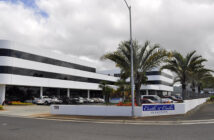Sydney, June 24, 2013 – Corporate Australia is responding to the challenge of harnessing mobility for operational and sales productivity, with Logicalis, the international IT solutions and managed services provider, noting significant proactive demand for strategic mobility consultancy outstripping reactive demand for BYOD point solutions.
To address changing customer requirements, Logicalis has outlined a five step process to help organisations reviewing their mobility options tackle the growing opportunity and challenge of enabling employees in different departments, roles and locations to use a myriad of devices, applications, data and content securely.
Devised by its experienced customer-facing solutions architects nationwide, Logicalis’ five step approach recognises that a successful mobile strategy allows employees to work ‘natively’ while using technology applications, devices and data for insights and automation to perform their role and meet KPIs, whether that’s measured through an increase in sales, more efficient marketing campaigns, reduced operational overheads or better customer service.
Logicalis’ approachalso acknowledges various stakeholders in the strategy with the user expecting an experience which matches how they like to work, the IT team expecting the solution to allow for self enrolment and onboarding of devices and the security team expecting apps and data to be delivered in a secure fashion whilst securing the network from the threats of the new devices. Management, HR, legal and IT, meanwhile, all expect the solution to be driven by tight policies while delivering tangible business value.
“We’re in the business of delivering “Tomorrow’s Workplace – work being something people do instead of a place they go,” said Oliver Descoeudres, Marketing Director at Logicalis. “This means we help customers identify, implement and manage technologies that strike a perfect balance between two business imperatives: technologies that enable operational efficiency and which give people the tools they need to do their best work.”
“Last year, six out of ten customer and prospect conversations were around BYOD where now easily nine out of ten people are proactively requesting strategic counsel on mobility as part of an operational productivity strategy. The focus on device ownership is somewhat misplaced given the spotlight should be on the value, processes and outcomes the device and its contents actually enable, but we see that the conversation on BYOD has essentially served as an interim step to where it needs to be,” added Descoeudres.
For more information, please visit http://www.au.logicalis.com/mobility or email oliverd@au.logicalis.com.
Logicalis’ five step approach incorporates the following principles:
Foundation: Strategy: the key to successful mobility is in the plan. It’s around gathering the business requirements for now and, if possible, for the next 1-3 years.
Step one: Policy: develop the policies needed to be able to implement a solution that will meet the business requirements. Those policies include HR, Legal, Security, and Usage. When these policies are created we can choose technologies that can deliver those policies, rather than choosing technologies and creating policies around the capabilities of the technology.
Step two: Network: it all starts at the network and the aim of unified access is to transform wired and wireless networks into one converged and unified infrastructure in order to create greater simplicity, greater intelligence, operational consistency and scale, ultimately leading to greater business agility and efficiency.
Step three: Devices: securing the device consists of mobile device management (MDM) technologies. Mobile Device Management (MDM) offers The CIO a way to address the management and control of both corporate owned and non-corporate owned mobile devices across both the main tablet platforms based on iOS and Android and a wide variety of smart phones.
Step four: Apps and data: being able to deliver the users apps, as they want to use them, and doing so in a user-centric secure manner.
Step five: Services: The services layer consists of solutions which can be overlayed on a mobility-enabled network. These consist of collaboration, Virtual Desktop Infrastructure (VDI), Bring Your Own Device (BYOD) towards the holy grail of Tomorrow’s Workplace.





